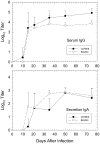Chlamydial infection of the gastrointestinal tract: a reservoir for persistent infection
- PMID: 23843274
- PMCID: PMC3751173
- DOI: 10.1111/2049-632X.12052
Chlamydial infection of the gastrointestinal tract: a reservoir for persistent infection
Abstract
The mechanism by which chlamydiae persist in vivo remains undefined; however, chlamydiae in most animals persist in the gastrointestinal tract (GI) and are transmitted via the fecal-oral route. Oral infection of mice with Chlamydia muridarum was previously shown to establish a long-term persistent infection in the GI tract. In this study, BALB/c, DBA/2, and C57Bl/6 mice, infected orally with C. muridarum, were infected in the cecum for as long as 100 days in the absence of pathology. The primary target tissue was the cecum although the large intestine was also infected in most animals. A strong serum IgG and cecal IgA antibody response developed. Lymphocyte proliferation assays to chlamydial antigen on mesenteric lymph node cells were positive by day 10 and peaked on days 15-21, but the response returned to baseline levels by 50 days, despite the ongoing presence of the organism in the cecum. Because studies have shown that women and men become infected orally with chlamydiae, we propose that the GI tract is a site of persistent infection and that immune down-regulation in the gut allows chlamydiae to persist indefinitely. As a result, women may become reinfected via contamination of the genital tract from the lower GI tract.
Keywords: Chlamydia; gastrointestinal tract; immunity; persistence.
© 2013 Federation of European Microbiological Societies. Published by John Wiley & Sons Ltd. All rights reserved.
Figures





References
-
- Ahmed SA, Gogal RM, Jr, Walsh JE. A new rapid and simple non-radioactive assay to monitor and determine the proliferation of lymphocytes: an alternative to [3H]thymidine incorporation assay. J Immunol Methods. 1994;170:211–224. - PubMed
-
- Bax CJ, Quint KD, Peters RPH, Ouburg S, Oostvogel PM, Mutsaers JAEM, Doerr PJ, Schmidt S, Jansen C, van Leeuwen AP, Quint WGV, Trimbos JB, Meijer CJLM, Morre SA. Analyses of multiple-site and concurrent Chlamydia trachomatis serovar infections, and serovar tissue tropism for urogenital versus rectal specimens in male and female patients. Sexually Transmitted Infections. 2011;87:503–507. - PubMed
-
- Bell TA, Stamm WE, Wang S, Kuo C, Holmes KK, Grayston JT. Chronic Chlamydia trachomatis infections in infants. JAMA. 1992;267:400–402. - PubMed
Publication types
MeSH terms
Substances
Grants and funding
LinkOut - more resources
Full Text Sources
Other Literature Sources
Medical
Research Materials
Miscellaneous

